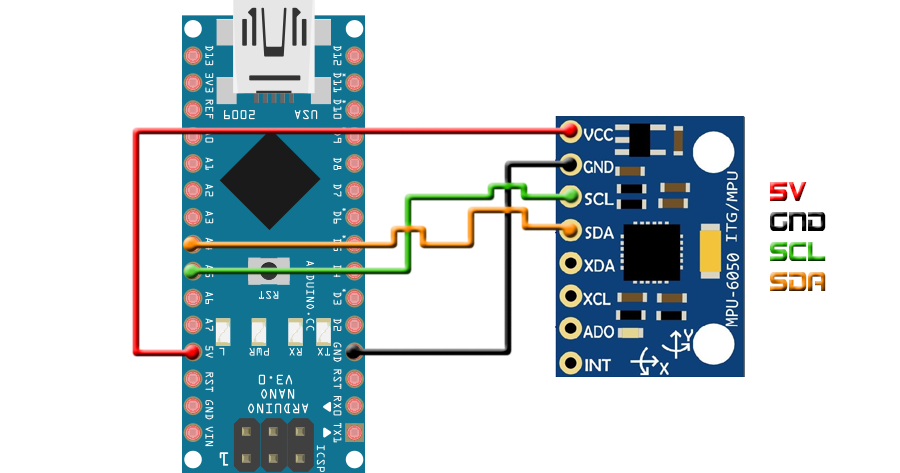Arduino drone V2.0 - Gyro raw data read
Unzip the file. Open the .ino file and upload it to the Arduino UNO/NANO. Make THIS connection open the serial monitor once uploaded. Remember to select 9600 baud rate or change the speed in the code.

Go back:
Or copy this code:
/* http://www.youtube.com/c/electronoobs
*
* This is an example where we configure te data of the MPU6050
* and read the gyro data and print it to the serial monitor
*
* Arduino pin | MPU6050
* 5V | Vcc
* GND | GND
* A4 | SDA
* A5 | SCL
*/
//Includes
#include <Wire.h>
//Variables
float elapsedTime, time, timePrev; //Variables for time control
int gyro_error=0; //We use this variable to only calculate once the gyro data error
int16_t Gyr_rawX, Gyr_rawY, Gyr_rawZ; //Here we store the raw data read
float Gyro_angle_x, Gyro_angle_y; //Here we store the angle value obtained with Gyro data
float Gyro_raw_error_x, Gyro_raw_error_y; //Here we store the initial gyro data error
void setup() {
Wire.begin(); //begin the wire comunication
Wire.beginTransmission(0x68); //begin, Send the slave adress (in this case 68)
Wire.write(0x6B); //make the reset (place a 0 into the 6B register)
Wire.write(0x00);
Wire.endTransmission(true); //end the transmission
Wire.beginTransmission(0x68); //begin, Send the slave adress (in this case 68)
Wire.write(0x1B); //We want to write to the GYRO_CONFIG register (1B hex)
Wire.write(0x10); //Set the register bits as 00010000 (1000dps full scale)
Wire.endTransmission(true); //End the transmission with the gyro
Serial.begin(9600); //Remember to set this same baud rate to the serial monitor
time = millis(); //Start counting time in milliseconds
/*Here we calculate the gyro data error before we start the loop
* I make the mean of 200 values, that should be enough*/
if(gyro_error==0)
{
for(int i=0; i<200; i++)
{
Wire.beginTransmission(0x68); //begin, Send the slave adress (in this case 68)
Wire.write(0x43); //First adress of the Gyro data
Wire.endTransmission(false);
Wire.requestFrom(0x68,4,true); //We ask for just 4 registers
Gyr_rawX=Wire.read()<<8|Wire.read(); //Once again we shif and sum
Gyr_rawY=Wire.read()<<8|Wire.read();
/*---X---*/
Gyro_raw_error_x = Gyro_raw_error_x + (Gyr_rawX/32.8);
/*---Y---*/
Gyro_raw_error_y = Gyro_raw_error_y + (Gyr_rawY/32.8);
if(i==199)
{
Gyro_raw_error_x = Gyro_raw_error_x/200;
Gyro_raw_error_y = Gyro_raw_error_y/200;
gyro_error=1;
}
}
}
}//end of setup void
void loop() {
timePrev = time; // the previous time is stored before the actual time read
time = millis(); // actual time read
elapsedTime = (time - timePrev) / 1000; //divide by 1000 in order to obtain seconds
//////////////////////////////////////Gyro read/////////////////////////////////////
Wire.beginTransmission(0x68); //begin, Send the slave adress (in this case 68)
Wire.write(0x43); //First adress of the Gyro data
Wire.endTransmission(false);
Wire.requestFrom(0x68,4,true); //We ask for just 4 registers
Gyr_rawX=Wire.read()<<8|Wire.read(); //Once again we shif and sum
Gyr_rawY=Wire.read()<<8|Wire.read();
/*Now in order to obtain the gyro data in degrees/seconds we have to divide first
the raw value by 32.8 because that's the value that the datasheet gives us for a 1000dps range*/
/*---X---*/
Gyr_rawX = (Gyr_rawX/32.8) - Gyro_raw_error_x;
/*---Y---*/
Gyr_rawY = (Gyr_rawY/32.8) - Gyro_raw_error_y;
/*Now we integrate the raw value in degrees per seconds in order to obtain the angle
* If you multiply degrees/seconds by seconds you obtain degrees */
/*---X---*/
Gyro_angle_x = Gyro_angle_x + Gyr_rawX*elapsedTime;
/*---X---*/
Gyro_angle_y = Gyro_angle_y + Gyr_rawY*elapsedTime;
//Serial.print("GyroX raw: ");
//Serial.print(Gyr_rawX);
//Serial.print(" | ");
Serial.print("GyroY raw: ");
Serial.println(Gyr_rawY);
//Serial.print(" | ");
//Serial.print("GyroX angle: ");
//Serial.print(Gyro_angle_x);
//Serial.print(" | ");
//Serial.print("GyroY angle: ");
//Serial.println(Gyro_angle_y);
}
Go back:

 About me
About me  History
History  Let's learn
Let's learn  Contact us
Contact us  Arduino tutorials
Arduino tutorials Circuits tutorials
Circuits tutorials  Robotics tutorials
Robotics tutorials Q&A
Q&A Blog
Blog  Arduino
Arduino  Circuits
Circuits Robotics
Robotics  Modules
Modules  Gadgets
Gadgets  Printers
Printers  Materials
Materials  3D objects
3D objects  3D edit
3D edit  Donate
Donate  Reviews
Reviews  Advertising
Advertising



